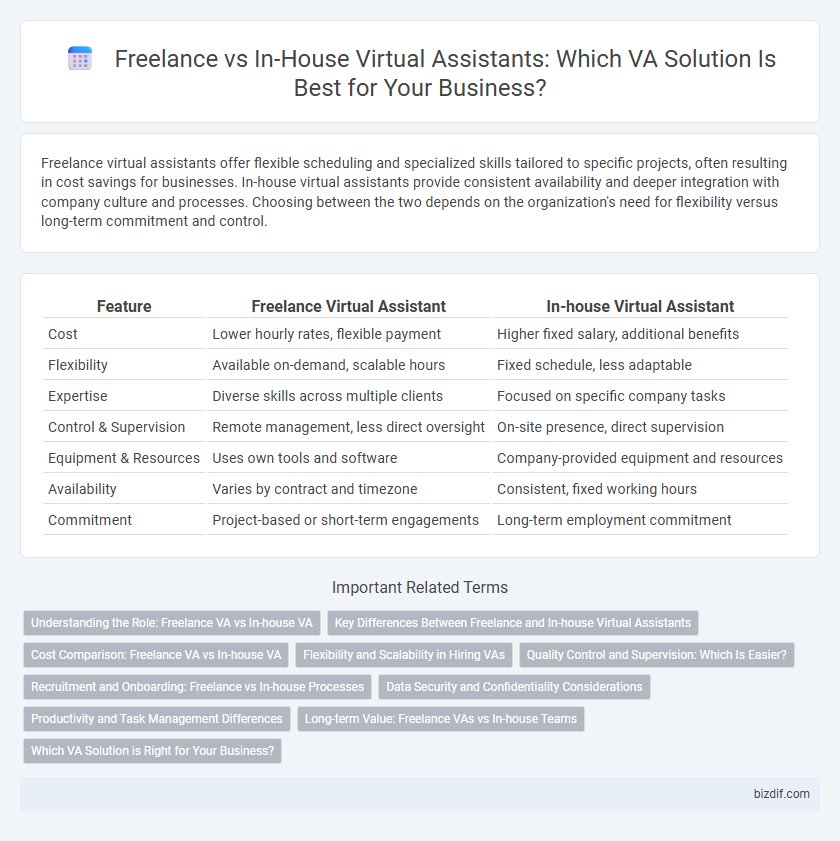Freelance virtual assistants offer flexible scheduling and specialized skills tailored to specific projects, often resulting in cost savings for businesses. In-house virtual assistants provide consistent availability and deeper integration with company culture and processes. Choosing between the two depends on the organization's need for flexibility versus long-term commitment and control.
Table of Comparison
| Feature | Freelance Virtual Assistant | In-house Virtual Assistant |
|---|---|---|
| Cost | Lower hourly rates, flexible payment | Higher fixed salary, additional benefits |
| Flexibility | Available on-demand, scalable hours | Fixed schedule, less adaptable |
| Expertise | Diverse skills across multiple clients | Focused on specific company tasks |
| Control & Supervision | Remote management, less direct oversight | On-site presence, direct supervision |
| Equipment & Resources | Uses own tools and software | Company-provided equipment and resources |
| Availability | Varies by contract and timezone | Consistent, fixed working hours |
| Commitment | Project-based or short-term engagements | Long-term employment commitment |
Understanding the Role: Freelance VA vs In-house VA
Freelance virtual assistants offer flexible, project-based support with diverse skill sets tailored to specific business needs, while in-house VAs provide consistent, dedicated assistance integrated within the company culture and daily operations. Understanding the role differences involves evaluating factors such as cost efficiency, availability, and control over task management. Businesses seeking agility often prefer freelance VAs, whereas those requiring long-term, seamless collaboration typically opt for in-house virtual assistants.
Key Differences Between Freelance and In-house Virtual Assistants
Freelance virtual assistants offer flexible availability and specialized skills tailored to project-specific needs, often working remotely with varied client bases. In-house virtual assistants provide consistent, dedicated support within a company's organizational structure, fostering deeper integration with internal teams and processes. Cost efficiency, control, and scalability remain primary factors distinguishing freelance VAs from their in-house counterparts in resource allocation and management.
Cost Comparison: Freelance VA vs In-house VA
Freelance virtual assistants typically offer lower hourly rates and eliminate expenses related to benefits, office space, and equipment compared to in-house VAs. In-house VAs incur fixed costs such as salaries, payroll taxes, healthcare, and overtime pay, which significantly increase total expenditure. Businesses seeking flexible budgets and scalability often find freelance VAs more cost-effective without sacrificing professional support.
Flexibility and Scalability in Hiring VAs
Freelance virtual assistants offer unmatched flexibility, allowing businesses to quickly adjust workloads without long-term commitments, ideal for fluctuating demands. In-house VAs provide consistent availability and deeper integration into company culture but can limit scalability due to fixed employment costs and longer onboarding processes. Choosing between freelance and in-house virtual assistants depends on how dynamically a business needs to scale its operations and manage its workforce budget.
Quality Control and Supervision: Which Is Easier?
Freelance virtual assistants offer flexibility but can pose challenges in maintaining consistent quality control due to remote supervision limitations. In-house virtual assistants enable direct oversight, allowing for immediate feedback and tighter adherence to company standards. Organizations prioritizing stringent quality assurance often find in-house VAs easier to supervise and manage effectively.
Recruitment and Onboarding: Freelance vs In-house Processes
Recruitment for freelance virtual assistants often involves online platforms like Upwork or Fiverr, enabling quick access to a diverse talent pool and flexible contract terms. In-house VA hiring requires formal job postings, structured interviews, and longer onboarding to align with company culture and internal systems. Onboarding freelancers typically centers on task-specific training and project management tools, while in-house VAs undergo comprehensive orientation, integration with teams, and ongoing professional development.
Data Security and Confidentiality Considerations
Freelance virtual assistants often operate remotely using personal devices and networks, which may increase the risk of data breaches compared to in-house VAs who work within a controlled office environment with company-managed security protocols. In-house virtual assistants benefit from direct supervision and access to secure internal systems, enhancing data protection and confidentiality. Organizations handling sensitive information should evaluate encryption standards, non-disclosure agreements, and secure communication channels when choosing between freelance and in-house virtual assistant options.
Productivity and Task Management Differences
Freelance virtual assistants offer flexible task management and often bring specialized skills that enhance productivity through project-based focus and autonomy. In-house virtual assistants benefit from deeper integration with company culture and real-time collaboration, leading to streamlined communication and quicker adaptation to shifting priorities. Productivity varies as freelancers excel in independent task completion, while in-house VAs thrive in dynamic environments requiring close teamwork and immediate feedback.
Long-term Value: Freelance VAs vs In-house Teams
Freelance virtual assistants offer cost-effective flexibility and specialized skills, ideal for project-based or fluctuating workloads, but may lack consistent availability and deep company integration. In-house VA teams provide long-term stability, stronger alignment with company culture, and dedicated support, which enhances productivity and institutional knowledge over time. Choosing between freelance and in-house VAs depends on balancing immediate cost savings with the strategic benefits of sustained collaboration and internal expertise development.
Which VA Solution is Right for Your Business?
Choosing between a freelance virtual assistant (VA) and an in-house VA depends on your business's specific needs, budget, and scalability goals. Freelance VAs offer flexibility, cost-efficiency, and specialized skills ideal for project-based or fluctuating workloads, while in-house VAs provide consistent availability, deeper company integration, and direct oversight crucial for ongoing, high-trust tasks. Assess factors such as workflow complexity, communication preferences, and long-term growth plans to determine the optimal VA solution for maximizing productivity and operational efficiency.
Freelance VA vs In-house VA Infographic

 bizdif.com
bizdif.com